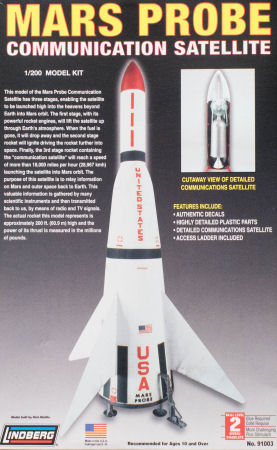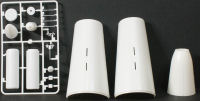
Lindberg 1/200 Mars Probe Kit First Look
By Michael Benolkin
| Date of Review | March 2016 | Manufacturer | Lindberg |
|---|---|---|---|
| Subject | Mars Probe | Scale | 1/200 |
| Kit Number | 91003 | Primary Media | Styrene |
| Pros | Nostalgic model back after a LONG time | Cons | See text |
| Skill Level | Basic | MSRP (USD) | $24.95 |
First Look
 |
 |
 |
 |
Dr. Werner von Braun was a visionary who dreamed of using the rocket to take man into space, but the reality of his early days of design were applied to his native Germany to create one of Hitler's super weapons, the V-2. After the war, von Braun was brought to the US to continue his work in rocket technology.
In the early 1950s, he designed a family of manned spacecraft that could be sent to Mars from an orbital space station he also designed. While none of these designs were every developed, Walt Disney and others used that vision to share that dream with the public. His vision and engineering was well thought out, but it came at a time before man had even succeeded in putting anything into orbit, much less achieving manned spaceflight. Much of this conceptualizing was put aside when the Soviet Union became the first nation to put an object into orbit - Sputnik 1 - in 1957. The space race was on and von Braun was pressed to get America into the game.
Lindberg (the original kit company) developed several kits of these conceptual spacecraft that von Braun had envisioned would be used to put man on Mars. This kit was originally released in the 1960s and was dug out of the archive of forgotten molds in 2007. The kit is still available and some hobby outlets have it marked down over 50%.
The kit is molded in white styrene and presented on three parts trees, plus the two halves of the first stage fuselage and the second stage fuselage. Two small trees molded in clear green styrene are provided representing the nozzle arrays of each stage. The kit is detailed for its age and provides the first and second stages as complete assemblies. The third stage is designed for the nose cone and shroud halves to be removable to reveal the communications satellite and its third stage delivery system. The communications satellite payload ironically resembles a stowed Sputnik.
If you look closer at the parts trees, you'll note a few items in the second photo that don't belong there. The kit also includes the winged Mars lander as an alternative to the commsat payload. No mention of this is made in the instructions, but since these parts are part of the kit, we'll likely be seeing the winged lander released in the future.
The boxtop says that a boarding ladder is included in the kit, though a loading truck/huge forklift is included. The kit also has four feet mounted to the bottom of the first stage which will make display of the rocket easier. You'll remember that many of the early concept designs as well as a few contemporary applications like DC-X were all equipped with such 'landing/launch' gear.
The kit includes the original design decals which definitely come from the early 1950s as the US flag (and these decals) had only 48 stars in those days.
This kit represents a point before the US and USSR took different approaches to spaceflight. Both nations had made use of the German rocket scientists to kick start their respective programs and von Braun's concepts represent the approach adopted by the Soviets - combine many smaller motors to lift a payload.
This will be an interesting addition to your rocket collection (or a good starting point for one) as this wasn't the material of science fiction, this was from the designs of Dr. Werner von Braun which did in fact inspire science fiction of the 1950s and 1960s.







